THE ORIGIN:
Before Portugal became Europe's first independent nation and a powerful empire, mankind roamed the Iberian Peninsula alongside his companion - the horse. This horse is, of course, the Iberian, whose descendents are amongst today's most admirable breeds; the Lusitano, the Andalusian and the Lipizzaner.
THE LEGEND: Around 5000 year ago, people from all cultures came from afar in search of the 'Centauro' legend (man-horse) of the Tejo delta. It was said that the unison between horse and rider was so harmonic and gracious that they were one. From then on, the Iberian became poetically known as the "Son of the Wind" (O Filho do Vento"), illustrating his power, wistfulness and elegance. | 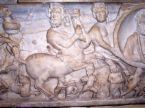 |
 Lusitano |  Andalusian |
Lipizzaner
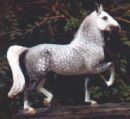
One of the most dated references found of the Iberian was discovered in 1963 in the form of engraving's on the wall's of the Escoural cave's in the Alentejo, Portugal. They are thought to date back to between 17,000 and 13,000 B.C. - although the time of origin of this ancient animal goes back to appproximately 30,000 B.C.
Despite their astonishing age, these engraving's illustrate a remarkable resemblance to the Lusitano of today, implying that he is the 'true' Iberian. Not only does genetical evidence strongly support this theory, as does the importance of this deserving breed throughout Portuguese history. During the centuries, his long, slightly convex face with a delicate muzzle, attentive ears and honest eyes, together with his muscular, compact body, all of which definitive features, have been carefully preserved by Portuguese breeders. |  |
IBERIAN TO LUSITANO:
The historical impact of this ancient bloodline deserves great appreciation for a number of reasons. First and foremost, he is one of the three pure warm blooded equine breeds in the world, alongside the Arabian and Thoroughbred. The latter, having been created by the cross-breeding of Iberian mares with Arabian stallions.
As one of the world's first domesticated horses, his advantageous influence on the way society functioned is truly undeniable. Agriculture became slightly less back-breaking and this new means of transport gave vast opportunity. However, his contribution to warfare meant a new era for combate and larger visions for those in power.
Warfare heavily contributed to the development of equestrian art and lead to a deeper understanding of the horse by those who became 'Masters'. 'Airs Above the Ground' were used as a means of attack and defense against the enemy. Today these incredible movements may be admired through the work of prestigious schools such as the 'Portuguese School of Equestrian Art', 'Spanish School of Viena' and the 'Cadre Noir of Saumur'.
 |  |
 | 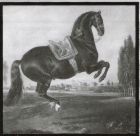 |
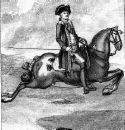 | 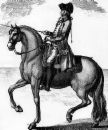 |
There is yet another element of Portuguese culture dating back to the origin of the country itself and of which the Lusitano has not only been at the heart of, but has also been specifically bred to do - Bullfighting.
Bullfighting became a public celebration around the same time Portugal was reconquered from the Moors by D. Alfonso Henriques in the XII century. By this time, the relationship between the horse and the bull - who, for many years before had roamed the plain's of what is now the Ribatejo and Alentejo of Portugal - had long been established. The Iberian rose tremendously to the occasion, conveying a natural understanding of the bull's astounding power and instinct, yet even in such confrontration, continued to obey his Master.
The strongest theory thought to explain the reason's behind the Iberian's division, thus creating the Lusitano and Andalusian, is based on the influence of this amazing tradition. Under the reign of King Filipe V, the Spanish were denied their mount's for this spectacle of bravery: primarily due to the King's animosity toward's the event, and secondly due to the rising of the Civil War. Hence, the beginning of a new era for Spanish culture, the 'Matador'. Therefore, while the Portuguese were selecting bloodlines on the basis of the horse's performance in sensational confrontation with the 'Toiro Bravo' (Iberian Bull), the Spanish were breeding in response to their general necessities - light warfare, agriculture, transport and leisure.
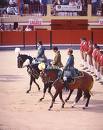 |  |
This brief description leaves a clear impression of the Lusitano's varied, not to mention unique history and hopefully has provided a small insight into what consideration's influenced the progression from the ancient Iberian to the present day Lusitano.
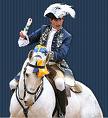 |  |